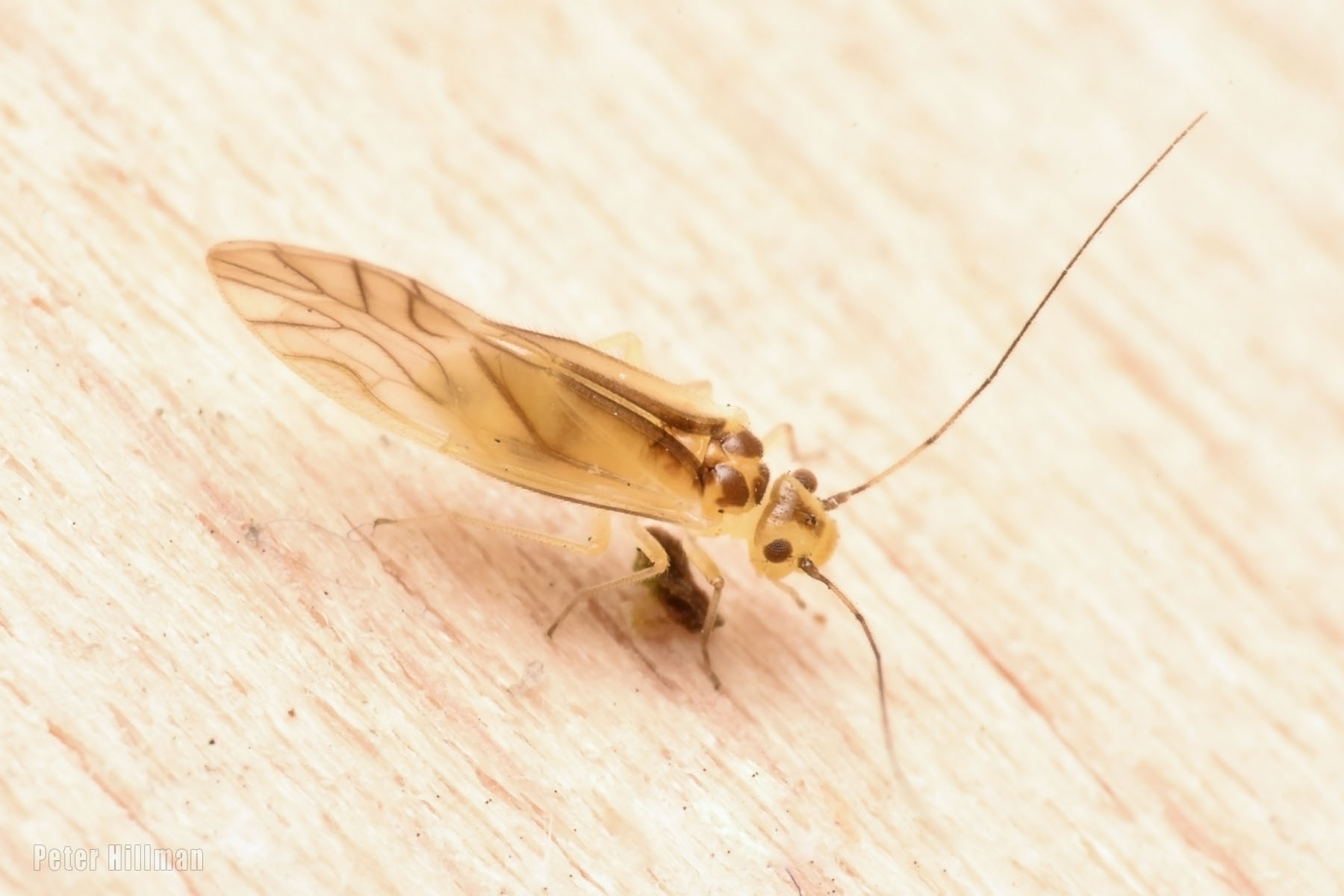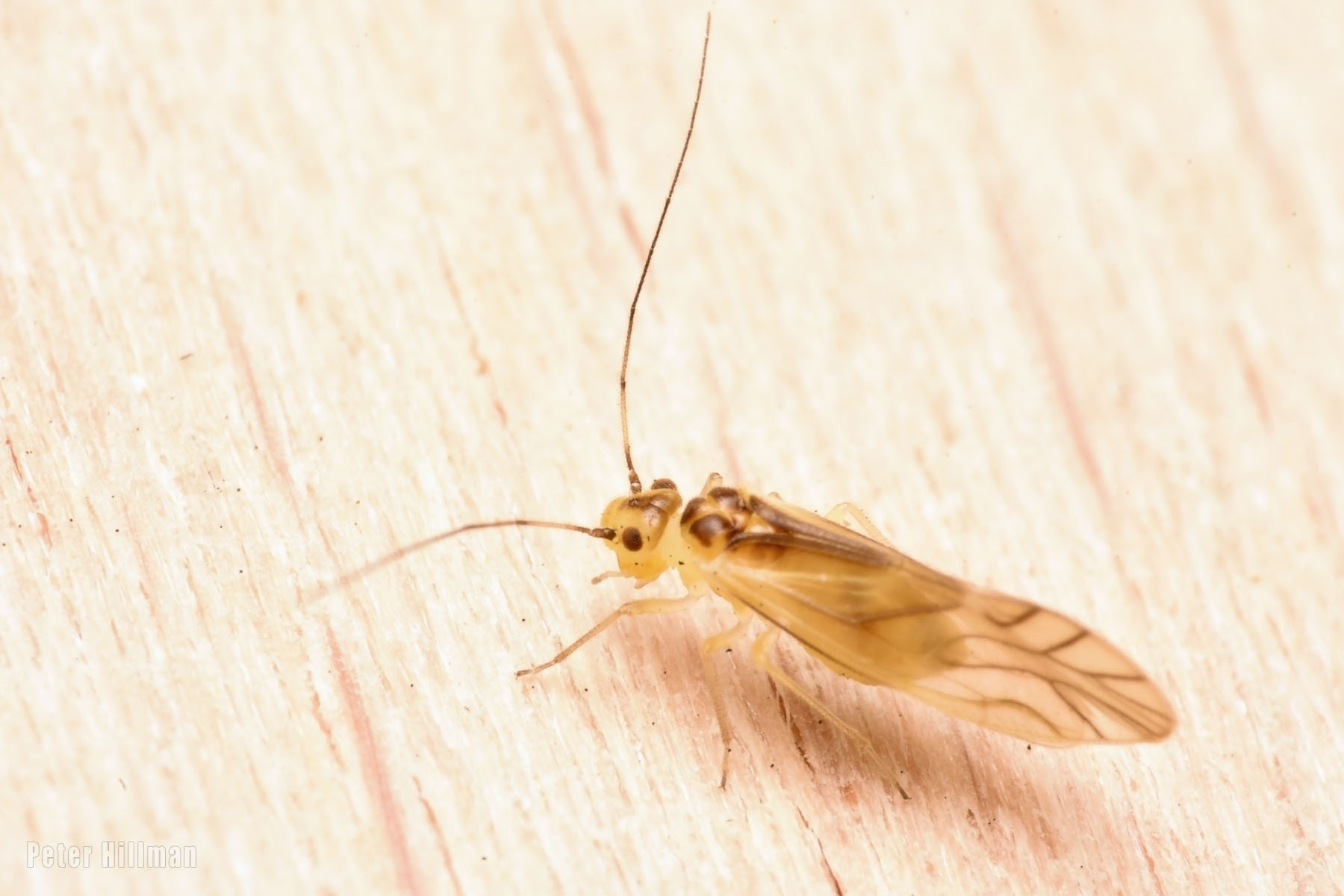The 1000th species to be added to this site was only discovered yesterday in my back garden, and it not only introduces this new species but also a new order of insects which I haven’t featured before – the Psocoptera.
This order includes the barklice and the booklice, and in some quarters prefer to be called barkflies. They are quite small insects ranging from 1.5-7 mm long, and can be confused with psyllids, jumping plant lice, which do what the names says and jumps when disturbed, where as barklice don’t jump. The reference to ‘lice’ is a bit of a misnomer as they are not parasitic but free-living insects.
Barklice feed on various ‘microflora (algae such as Pleurococcus, lichens and fungi) or on more general organic matter which often occurs on surfaces of bark or the foliage of trees. Not all barklice are associated with trees, as some are found in low vegetation, leaf litter and under stones. Some species are fully winged, and some are only partially winged or wingless.
There are around 4,400 psocid species worldwide, 1,000 in Europe, and 100 in Britain, and many go unoticed and unrecorded, although most every tree is likey a home to them. 68 of these species come under the barklice or barkflies umbrella which are found outdoors, and the remaining booklice are found indoors. These are wingless and grow up to around 2 mm long. They are most commonly found in human dwellings and warehouses where they feed on stored grain, book bindings, wallpaper paste and other starchy products, and on the minute traces of mould found in old books. They can sometimes cause damage to stored museum collections of insects and plants. A few Psocoptera live in bird nests feeding on feathers and dead skin cells.
Psocoptera are regarded as one of the most primitive amongst insects, as their mouth parts show little modification from those of the earliest known fossils.
Valenzuela flavidus – At around 3 mm (1/8 in) long, this is quite an attractive species with pale yellow colouring and distinct brown markings. During summer and autumn it is mainly found on branches of deciduous trees and bushes, though occasionally also on conifers and evergreen branches. During winter and spring it is found in leaf litter.


Well done on the 1000th and fascinating. Look forward to the next chapter.
Hope your health has improved.
LikeLiked by 2 people
Thank you very much, susieQ! 🙂
LikeLiked by 1 person
What a record!
LikeLiked by 1 person
Thank you 🙂
LikeLike
Congratulations on recording such a large number. I’ve never heard of barklice and booklice so it was interesting to read about them.
Thanks for sharing, Pete.
LikeLiked by 1 person
Thank you very much, Vicki! I am glad you enjoyed the post 🙂
LikeLike
Congratulations – what an interesting insect to round off the 1 000 species! I too am looking forward to the next thousand. You really do either have excellent observation skills or a keen nose for finding such tiny creatures!
LikeLiked by 1 person
I appreciate that, Anne, thank you 🙂 Sometimes I am just lucky, and others a kind of sixth sense helps out, I am sure 🙂
LikeLiked by 1 person
1000 species!! That’s something very impressive and absolutely amazing Pete!! This one is very special like so many others that you shared.
LikeLiked by 1 person
Thank you very much, Anita 🙂 A passion for something can keep you driving forward.
LikeLiked by 1 person
Wow, impressive camerawork, Pete, as well as reaching the 1000-milestone! Congrats, a fine achievement.
LikeLiked by 1 person
Many thanks, Eliza 🙂 I always enjoy discovering something new, especially if it is in my own back yard 🙂
LikeLiked by 1 person
Acres of Diamonds! 😉
LikeLiked by 1 person
🙂
LikeLike
So beautiful Pete! Almost looks like glass or resin. You have a good eye! I hope you’re doing well my friend.
LikeLiked by 1 person
Thank you, Sandra 🙂 One of those lucky finds, and thankfully it kept still long enough for me to photograph it 🙂
LikeLiked by 1 person
You haven’t disappointed with the inaugural creature of your second thousand!
Amazing, that an insect so little changed over the eons now thrives on the book bindings and wallpaper pastes provided by humans. Evolutionary heroes.
LikeLiked by 1 person
Thank you, Rebecca 🙂 This is why, despite our best attempts to eradicate insects through one means or another, they will outlive us and will continue to adapt.
LikeLike
Congratulations – well done! 🙂
LikeLiked by 1 person
Thank you, Anki 🙂
LikeLiked by 1 person
Wow! Congrats that is quite the accomplishment.
LikeLike
Thank you! 🙂
LikeLiked by 1 person
They remind me a bit of the winged cockroaches we have around here, which are terrifying.
Wildlife come in many shapes and forms. Here, we have a huge amount of feral cats that decorate the streets with their different colors, and their playfulness and intelligence. Eyes that piece the dark like something out of a magic fairy tale. And there was an armload of butterflies last spring.
LikeLiked by 1 person
How are you celebrating this marvelous millenium milemarker? I hope you have acquired a special single malt for the occasion (if you share that passion)!
LikeLiked by 1 person
No celebrating here, just keep on pushing forward, thank you, Gary 🙂
LikeLiked by 1 person
Congratulations, Pete! And thank you for building this showcase of fascinating species over the years.
LikeLiked by 1 person
Many thanks, Anita! I appreciate that! 🙂
LikeLiked by 1 person
Cool bugs, Pete. 1000 is quite a menagerie. I’ve found bark lice larvae but no adults yet. The larvae are usually in huge numbers.
LikeLiked by 1 person
Many thanks, Steve 🙂 I have found a few larvae, too, but it is hard enough to try to id some of the adults let alone the larvae! 🙂
LikeLiked by 1 person